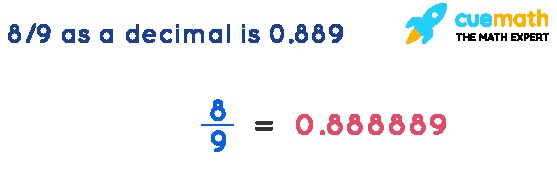Are you curious about what the decimal equivalent of 9/8 is? Well, look no further! In this article, we’ll dive into the world of decimals and explore how to convert fractions like 9/8 into their decimal counterparts. Whether you’re a math enthusiast or just looking to brush up on your number skills, understanding how to convert fractions to decimals is a valuable skill. So, let’s jump right in and discover the decimal representation of 9/8!
9/8 as a Decimal
Have you ever wondered what the decimal equivalent of the fraction 9/8 is? In this article, we will explore the fascinating world of decimals and uncover the decimal representation of 9/8. Understanding decimals is an essential skill that can help you in various real-life scenarios such as measurements, money, and mathematical calculations. So, let’s dive in and discover how to express 9/8 as a decimal!
Understanding Fractions and Decimals
Before we delve into the decimal representation of 9/8, let’s first understand what fractions and decimals are.
Fractions represent parts of a whole or a division of a quantity into equal parts. They consist of a numerator (the number above the fraction line) and a denominator (the number below the fraction line). For example, in the fraction 3/4, 3 is the numerator, and 4 is the denominator.
Decimals, on the other hand, are a way of representing fractions using a decimal point and place value. A decimal point separates the whole number part from the fractional part. Each digit to the right of the decimal point has a specific value based on its position, such as tenths, hundredths, and so on.
Converting Fractions to Decimals
To convert a fraction to a decimal, there are a few methods we can use. In the case of 9/8, we have two common approaches: long division and using a calculator.
Method 1: Long Division
Long division is a traditional method for converting fractions to decimals. Here’s how we can apply it to find the decimal representation of 9/8:
Step 1: Divide the numerator (9) by the denominator (8).
“`
1.125
___________
8 | 9.000
– 8
—–
10
– 8
—–
20
– 16
—–
4
“`
Step 2: Bring down the next digit of the numerator (0) and continue dividing.
“`
1.125
___________
8 | 9.000
– 8
—–
10
– 8
—–
20
– 16
—–
40
– 40
—–
0
“`
Step 3: Continue dividing until we obtain the desired level of accuracy or a repeating pattern.
By performing the long division, we find that 9/8 as a decimal is equal to 1.125.
Method 2: Calculator
Using a calculator is a quick and efficient way to convert fractions to decimals. Most modern calculators have a dedicated fraction-to-decimal button that simplifies the process.
To convert 9/8 to a decimal using a calculator, follow these simple steps:
Step 1: Enter the fraction 9/8 on your calculator.
Step 2: Press the fraction-to-decimal conversion button.
Step 3: Read the decimal representation on the calculator’s display.
Using this method, we find that 9/8 as a decimal is also equal to 1.125.
Decimal Equivalents of Common Fractions
Understanding the decimal equivalents of common fractions can be useful in various situations. Here is a table showcasing the decimal equivalents of some commonly used fractions:
| Fraction | Decimal Equivalent |
|---|---|
| 1/2 | 0.5 |
| 1/3 | 0.333… |
| 2/3 | 0.666… |
| 1/4 | 0.25 |
| 3/4 | 0.75 |
| 1/5 | 0.2 |
| 2/5 | 0.4 |
| 3/5 | 0.6 |
| 4/5 | 0.8 |
| 1/6 | 0.166… |
The Importance of Decimal Equivalents
Understanding decimal equivalents is crucial in many practical scenarios. Here are a few areas where knowledge of decimal equivalents can be highly valuable:
Measurements:
Converting between fractions and decimals is essential when dealing with measurements. For example, in cooking, a recipe may call for a specific measurement in fraction form, but you need to convert it to a decimal to accurately measure the ingredients.
On a Ruler:
Rulers are often marked with fractional and decimal measurements. Knowing the decimal equivalents of common fractions allows you to read measurements more precisely and efficiently.
Money:
Decimals are extensively used in monetary transactions. Calculating prices, discounts, and making accurate financial decisions often involves converting decimals to fractions or vice versa.
Mathematical Calculations:
Many mathematical operations, such as addition, subtraction, multiplication, and division, involve decimals. Converting fractions to decimals enables us to perform these calculations more easily and accurately.
In conclusion, 9/8 as a decimal is equal to 1.125. Understanding fractions and their decimal equivalents is a valuable skill that can assist you in various real-life situations. Whether you need to measure ingredients, work with measurements on a ruler, handle financial transactions, or perform mathematical calculations, knowing how to convert between fractions and decimals is essential. Hopefully, this article has provided you with a comprehensive understanding of 9/8 as a decimal and opened doors to the exciting world of fractions and decimals.
8/9 as a Decimal
Frequently Asked Questions
What is 9/8 as a decimal?
The decimal equivalent of 9/8 is 1.125.
How do I convert 9/8 to a decimal?
To convert 9/8 to a decimal, divide the numerator (9) by the denominator (8). The result is 1.125.
Can 9/8 be simplified as a decimal?
No, 9/8 cannot be simplified further as a decimal. The fraction itself, 9/8, is already in its simplest form.
Is 1.125 the only decimal representation of 9/8?
Yes, 1.125 is the only decimal representation of 9/8. It is the exact decimal value of the fraction.
Is 9/8 a recurring decimal?
No, 9/8 is not a recurring decimal. It terminates after the third decimal place, which is 1.125.
Final Thoughts
In conclusion, when we express the fraction 9/8 as a decimal, we get 1.125. This decimal value represents dividing the numerator (9) by the denominator (8). It is a useful conversion when dealing with fractions in decimal form, as it allows for easier calculations and comparisons. By understanding the concept of converting fractions to decimals, we can simplify mathematical operations and make them more accessible. So, if you come across the fraction 9/8, you can easily convert it to a decimal by dividing 9 by 8, resulting in 1.125.




